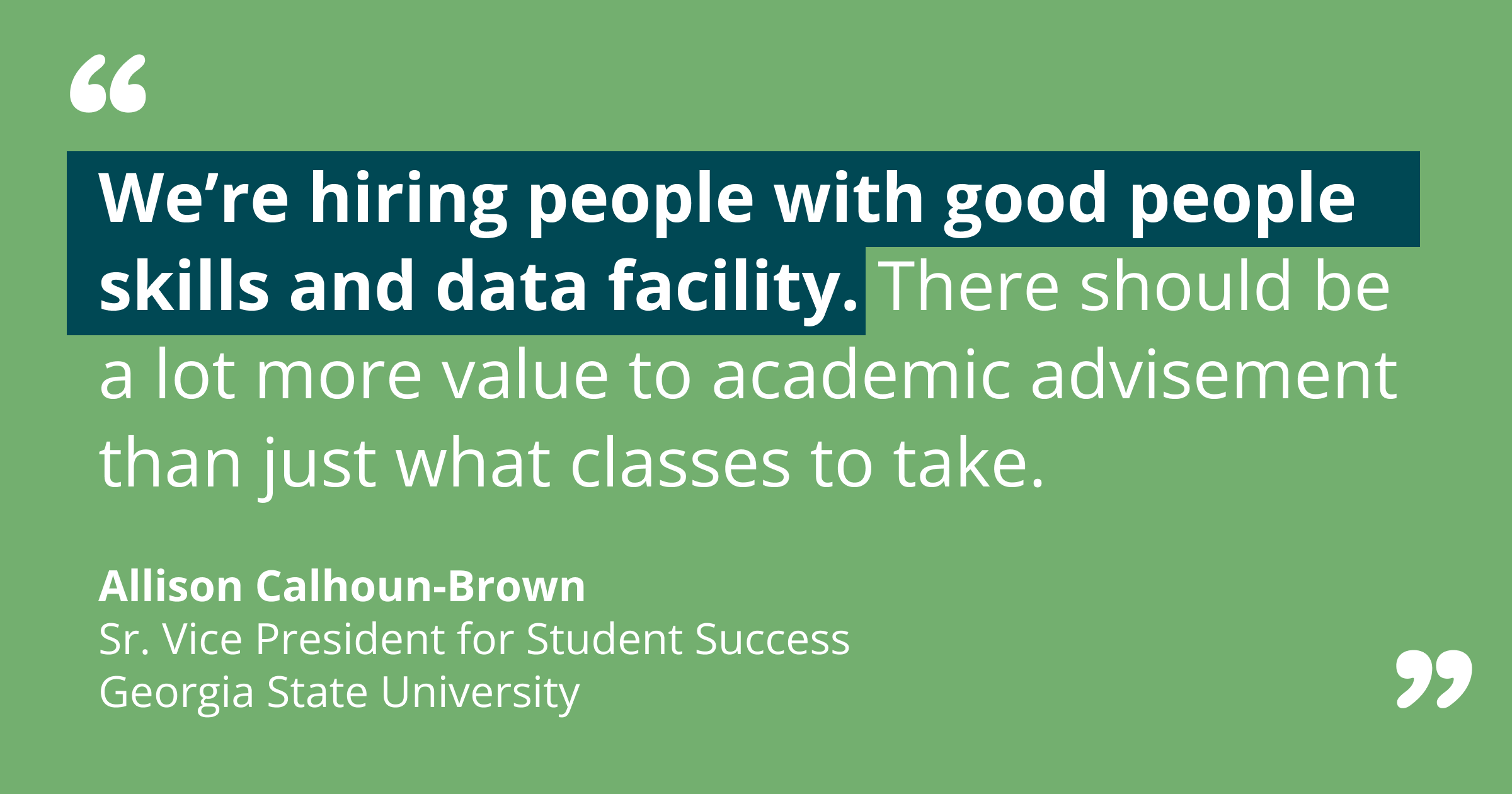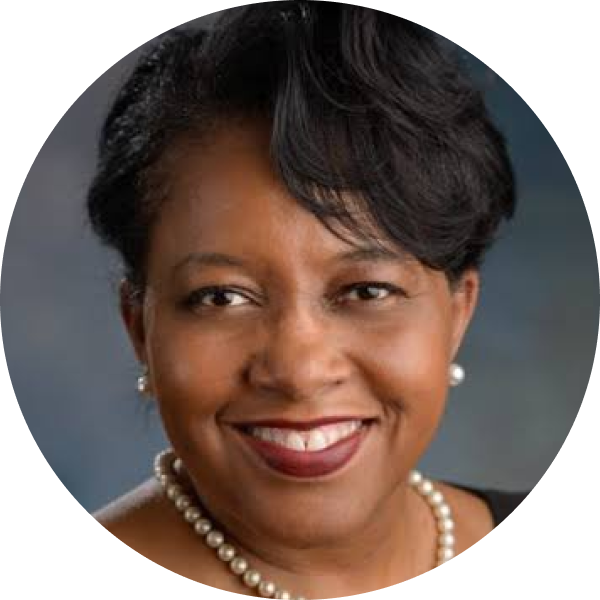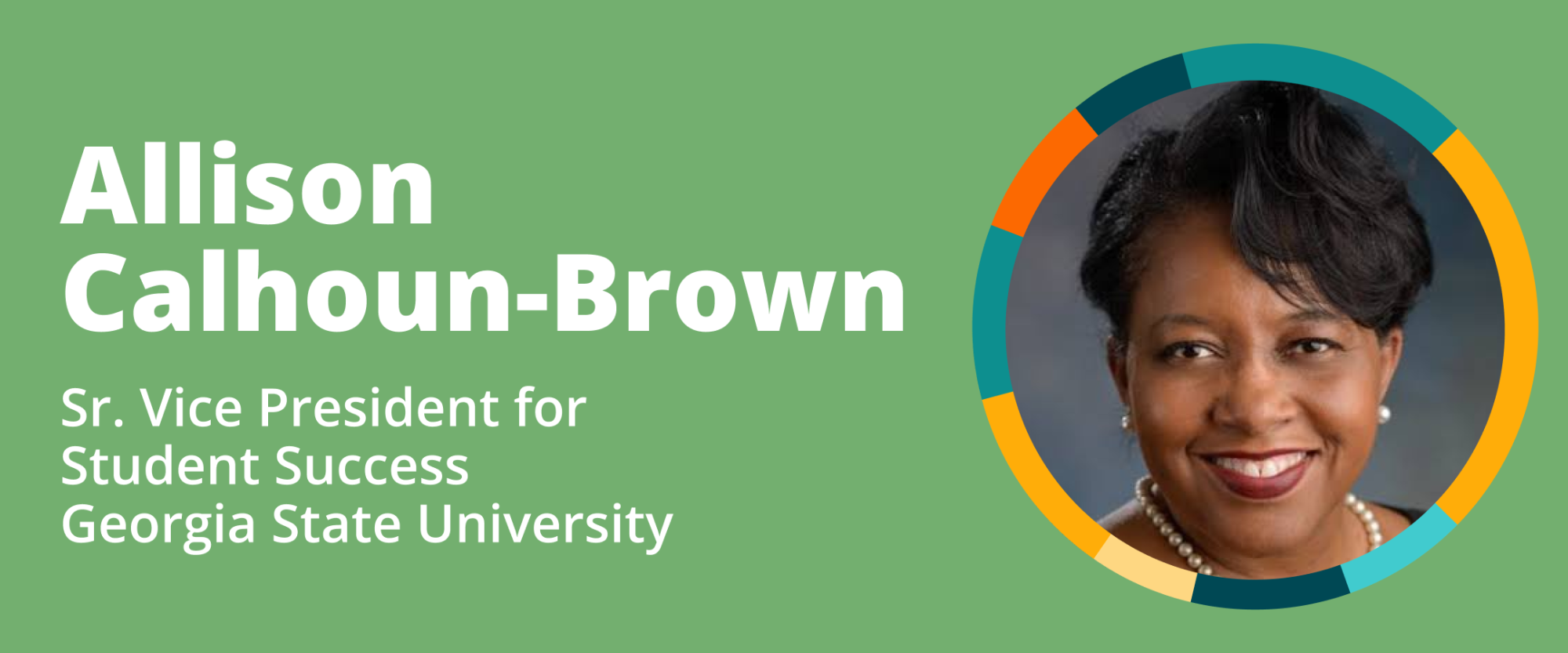With student success innovation as a focal point for the 2024 University Innovation Alliance National Summit, we were honored to hear from Dr. Allison Calhoun-Brown, Senior Vice President for Student Success at Georgia State University (GSU). Her presentation was a lesson in how to turn academic advising into a student success machine as she shared her institution’s four-point playbook for ramping up advisors’ practice into an integral part of university culture.
Student Success Data Collection Then and Now
While GSU’s academic advising program has become a national model for student success, Dr. Calhoun-Brown described how, as recently as 2012, advisors were keeping track of student appointments with hash marks on paper: “If you asked how many people were being seen, we could not tell you with any confidence. And if you don't know how many people, you can't ask more sophisticated questions about advising like: How effective? How often? How strategic?”
For a 50,000-student university, there was no consistency of practice across its colleges and departments. For an institution with many low-income and first-generation students from underrepresented minority groups, proactive advising was just a dream. Dr. Calhoun-Brown observed, “You don't do anything but put out fires when you have one advisor for 1200 students.”
Yet by 2024, GSU had built a centralized academic advising structure that now sees over 100,000 annual student visits – one student meeting with one advisor. This unified, streamlined approach saves the university many hours and dollars while benefiting more struggling students with timely interventions to help them excel academically and graduate. Reaching this point didn’t come easily, so Dr. Calhoun-Brown shared her four-point playbook to help other institutions better implement these practices to better serve their students.
Playbook Item #1: Get the Data
Collecting institution-wide data begins with two objectives:
- Ensure that the data you’re collecting is clear in what it represents, organized well enough for everyone to understand what they’re looking at, and available across the institution to anyone who needs it.
- Decide what you want to know about the students and how you can be proactive in that knowledge.
Dr. Calhoun-Brown explained that achieving these objectives can pave the way for predictive analytics once you answer these questions:
- Are we tracking withdrawals, how students perform in prerequisite courses, whether they register for the next semester in a timely manner?
- Are we checking whether they’re under-enrolled or meeting their milestones?
- Are there any early alerts by the faculty?
- Is anybody doing anything with this information? Long before you get to predictive analytics, what do you want to know?
Actionable academic data is the core of proactive advising, while predictive analytics embody a set of tools that help institutions share and build strategies from this data. Early in their student success mission, GSU partnered with Education Advisory Board (EAB), a technology and research leader in the higher ed space.
Predictive analytics are a method of data analysis. It often involves machine learning and statistical modeling to predict failures. It can be a very effective outreach because it uses statistical analyses that we wouldn't be able to do easily on our own. If you give it the data, it will work. But that alone isn’t the magic for improving academic advising on your campus.
Playbook Item #2: Establish a Standard of Care
While often used in a healthcare context, standard of care generally refers to a level of service expected from knowledgeable, skilled professionals fulfilling their mission with best intentions. For academic advising, standard of care begins with establishing an institution-wide board or committee to set uniform guidelines across all the colleges and departments. Dr. Calhoun-Brown suggested starting with these questions:
- What constitutes an advising appointment?
- What elements should be in every advising appointment?
- When should students get advisement?
- What could all transfer and first-year students expect about academic advisement?
"We have to figure out what it looks like so that there can be some consistency.”
On the administrative side, this requires establishing common measures of effectiveness by asking:
- What interventions will you use?
- Where will the notes and records be stored so that they can be easily accessed?
- How coordinated are the supports?
- What does the training look like?
- How does that change over time?
It takes attentive, committed leadership to ask these basic procedural questions, facilitate the conversations, and use the outcomes to establish a standard of care for all students who rely on academic advising programs.
Playbook Item #3: Generate Buy-in
In any sector, institutional transformation can happen only when the stakeholders are ready to buy in. This is where motivated, engaged leadership is critical in bringing everyone to the table. Dr. Calhoun-Brown recalled how GSU’s then-president Mark Becker had 30-40 college deans and academic advisors sitting at a long table for this conversation:
He said, "We are going to do advising differently, and this means you. We're going to have some reports, and if everybody's not participating, we're going to come back together. That can't happen." He focused the university community on doing things differently. And we did. A senior-level sponsor built the case for the ROI. The investment may be a lot, but it's going to pay for itself many times over. We were able to increase student retention in the first year about six or seven points. With 50,000 students, that's going to add up. So, this is how to change the culture to support advisement changes.
GSU enabled its cultural change with structural changes like creating new positions and career ladders for academic advisors, as well as working with the IS&T department to build a data and advising infrastructure for campus-wide collaboration. Faculty and staff were invited to participate, along with the main beneficiaries of any advising program: the students. “Supporting student engagement is critical,” Dr. Calhoun-Brown emphasized. “Don't forget the students.”
Playbook Item #4: Support Student Engagement
She admitted that her team could have checked in with the students much earlier than they actually did, because transparency matters for everyone involved. They ultimately sought answers to these questions:
- What are students’ expectations?
- How would they like us to communicate those expectations?
- When should we communicate them?
- Did anybody ask students when they want advisement or for how long?
Our learning management system lets us track how many times do the students sign in or not sign in, but we should tell students that we're tracking the data from the LMS, how we're utilizing their data. The privacy considerations are important. You want to be able to evaluate your efforts and refine strategies, looking for the equity gaps. Who's coming in? Who's not coming in? Who's benefiting from these outreaches? Who's not benefiting? Sometimes, there are demographic implications.
Dr. Calhoun-Brown urged institutions to develop a narrative explaining the impact of advising, a key factor to building momentum in the campus community. Whether it’s telling the stories of individual students who benefited from advising, sharing examples of students earning their degree sooner thanks to staff intervention, or showing the numbers to illustrate ROI, it can only help to spotlight the benefits of advisement.
“You need someone who's going to the senate committees, talking to the cabinet, and talking to the president, provost, and deans about the program’s success, because it will start to build on itself.”
Blending Data Into Advising Practice
Individual students are ultimately responsible for their own success. However, to foster success at scale, Dr. Calhoun-Brown insisted that data is essential. She described a standard practice in GSU’s Student Success division:
My data guy comes to all the meetings with me, and he hears the discussions and then says, "Oh, we got data to answer this." And sometimes in the meeting or right after the meeting, he can share. As you democratize data, you need to develop data experts who are close to the practice, can inform the data definitions, and make sure that there's integrity.
She also explained how data awareness informs the extensive training that her academic advisors receive:
It's not just a matter of mandating a system. We had to develop data infrastructure. And over time, we changed the hiring standards to still hire people with good people skills, but also who had data facility. That's allowed us to get to the point that we're doing well now with our data and academic advising. There's a lot more value add that should be coming from academic advisement than just what classes to take.

Note: This episode of the University Innovation Alliance’s Innovating Together Podcast originally aired on May 5, 2025. The podcast appears live on YouTube, Facebook, Twitter, and LinkedIn.
Resources Mentioned in This Episode
- Dr. Allison Calhoun-Brown
- Georgia State University
- "Our First Decade of Innovation: The UIA’s 2024 Annual Report," UIA, 2025
- "The Future of Academic Advising,” UIA, 2022
- Predictive analytics: an approach for increasing student success via aggregated data
- Education Advisory Board (EAB): a technology company and research leader in the higher ed space
- University Innovation Alliance National Summit, UIA, 2024
- “Reflections on a Career in Leadership,” A conversation with Mark Becker, former president of Georgia State University, UIA, 2021
Watch the Archive
Bios of Guest and Host

Dr. Allison Calhoun-Brown is Senior Vice President for Student Success at Georgia State University. Since 2008, she has overseen many of Georgia State’s success programs, using data to develop strategic initiatives that promote student achievement, facilitate academic progression, enhance the student experience and increase graduation rates. Incorporating predictive analytics, Dr. Calhoun-Brown has implemented new and innovative programming to address issues of effective academic advising, unmet student financial need, curricular progression barriers, momentum year strategies, and support for at-risk students. Her efforts have contributed to the elimination of achievement gaps at Georgia State. In 2019, she became the chief student affairs officer at GSU with the goal of integrating the student success approach across all aspects of student life and engagement at the University. Dr. Calhoun-Brown graduated with honors from Oberlin College and earned master’s and doctoral degrees in political science from Emory University.

Host: Bridget Burns, Executive Director, University Innovation Alliance
As a trusted advisor to university presidents and policymakers, Dr. Bridget Burns is on a mission to transform the way institutions think about and act on behalf of low-income, first-generation, and students of color. She is the founding CEO of the University Innovation Alliance, a multi-campus laboratory for student success innovation that helps university leaders dramatically accelerate the implementation of scalable solutions to increase the number of college graduates.
About Innovating Together
Innovating Together is an event series that happens live on YouTube, Facebook, Twitter, and LinkedIn. It also becomes a podcast episode. Every week, we join forces with Inside Higher Ed and talk with a higher education luminary about student success innovations or a sitting college president or chancellor about how they're specifically navigating the challenges of leadership. We hope these episodes will leave you with a sense of optimism and a bit of inspiration.
Rate, Review & Subscribe
Learn why hundreds of people have rated the Innovating Together podcast 5 stars. Please join others and rate and review this podcast. This helps us reach and inform more people -- like you -- who are committed to helping more students succeed.
Click here, scroll to the bottom, tap to rate with five stars, and select “Write a Review.” Then be sure to let us know what you loved most about the episode. Also, if you haven’t done so already, subscribe to the podcast. You'll never miss an episode.

